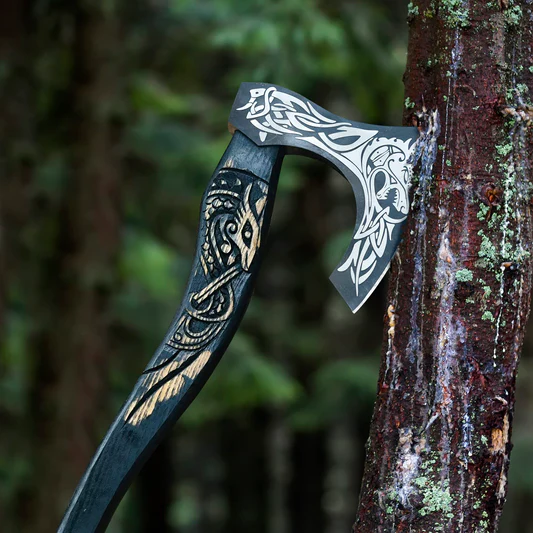The Viking age was a tumultuous period marked by widespread exploration, raiding, and conquest. Central to the Vikings’ success in battle was their weaponry, and among the most iconic and fearsome tools of war was the Viking battle axe. Revered for its unrelenting power, the Viking battle axe was more than just a tool for combat it was a symbol of their martial prowess and an integral part of their culture. Forged with precision and a keen understanding of metallurgy, the Viking battle axe was a weapon designed for both function and aesthetics. Its head, typically composed of iron or steel, featured a curved blade with a sharpened edge on one side and a brutal, elongated spike on the other. This dual-purpose design allowed the wielder to switch between cleaving through enemies’ armor and delivering piercing thrusts, making the Viking battle axe a versatile tool on the battlefield. The haft was not merely a means of wielding the weapon it was an extension of the Viking warrior’s body and spirit.

One of the defining features of the Viking battle axe was its haft, the wooden handle that connected the head to the warrior’s grip. Crafted from materials like ash or oak, the haft was often embellished with intricate carvings and runes, symbolizing the warrior’s lineage, achievements, or invoking protective powers. The length of the haft varied, with some axes being wielded with one hand for agility, while others were designed for two-handed use, delivering devastating blows with immense force. In battle, the Viking battle axe demonstrated its unrelenting power through its effectiveness against a wide array of adversaries. The Vikings’ frequent raids and conquests took them to diverse landscapes, where they encountered different forms of armor and combat tactics. The axe’s ability to bypass shields, crush armor, and deliver deadly wounds made it a formidable weapon against both lightly armored opponents and heavily fortified foes. These ferocious fighters, often equipped with the battle axe, struck fear into the hearts of their enemies.
Their relentless onslaught and disregard for personal safety made them a terror on the battlefield, as they hewed through enemy lines with savage determination. It played a significant role in the Viking belief system and social hierarchy. Owning a finely crafted battle axe was a mark of a warrior’s status and skill, and it held a place of honor in Viking society. This connection elevated the axe’s significance to a spiritual level, imbuing it with a mystical aura that further fueled the Vikings’ fervor in battle. The Viking battle axe’s unrelenting power did not wane with the passing of the Viking age. Its influence can be traced in various cultures and time periods that followed, leaving an indelible mark on the history of weaponry. Even today, Handgeschmiedete Äxte remains a symbol of the warrior spirit and an enduring testament to the craftsmanship and ingenuity of the Norse people. With its intricate design, brutal effectiveness, and rich symbolism, the battle axe became an emblem of the Viking age and continues to captivate our imagination as a relic of a bygone era characterized by both brutality and artistry.
